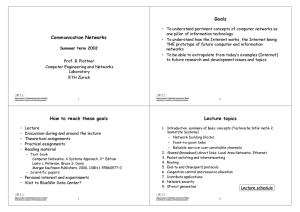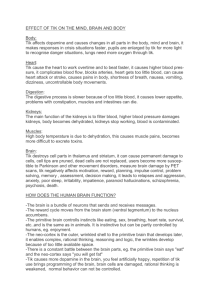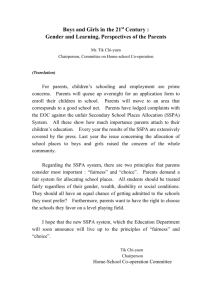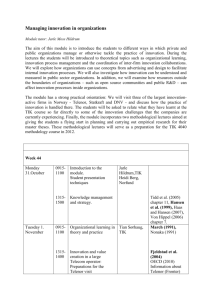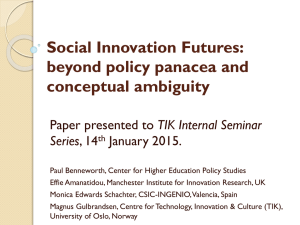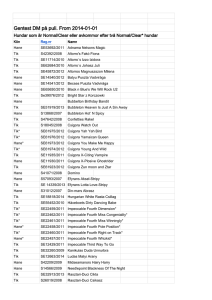preprint
advertisement
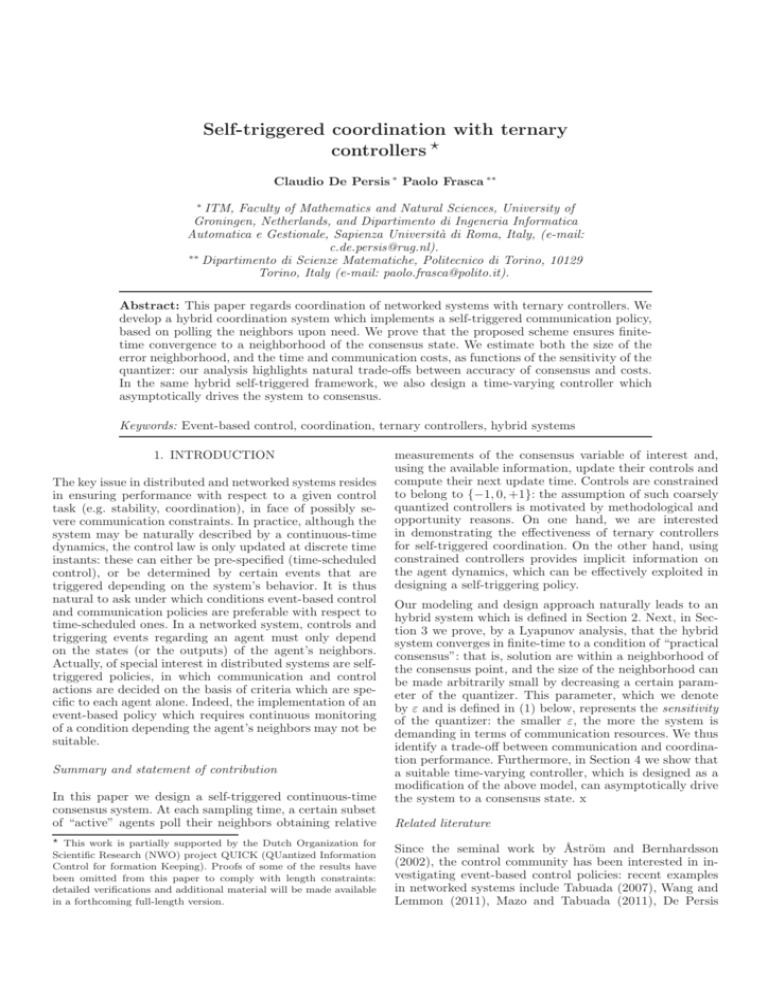
Self-triggered coordination with ternary
controllers ⋆
Claudio De Persis ∗ Paolo Frasca ∗∗
∗
ITM, Faculty of Mathematics and Natural Sciences, University of
Groningen, Netherlands, and Dipartimento di Ingeneria Informatica
Automatica e Gestionale, Sapienza Università di Roma, Italy, (e-mail:
c.de.persis@rug.nl).
∗∗
Dipartimento di Scienze Matematiche, Politecnico di Torino, 10129
Torino, Italy (e-mail: paolo.frasca@polito.it).
Abstract: This paper regards coordination of networked systems with ternary controllers. We
develop a hybrid coordination system which implements a self-triggered communication policy,
based on polling the neighbors upon need. We prove that the proposed scheme ensures finitetime convergence to a neighborhood of the consensus state. We estimate both the size of the
error neighborhood, and the time and communication costs, as functions of the sensitivity of the
quantizer: our analysis highlights natural trade-offs between accuracy of consensus and costs.
In the same hybrid self-triggered framework, we also design a time-varying controller which
asymptotically drives the system to consensus.
Keywords: Event-based control, coordination, ternary controllers, hybrid systems
1. INTRODUCTION
The key issue in distributed and networked systems resides
in ensuring performance with respect to a given control
task (e.g. stability, coordination), in face of possibly severe communication constraints. In practice, although the
system may be naturally described by a continuous-time
dynamics, the control law is only updated at discrete time
instants: these can either be pre-specified (time-scheduled
control), or be determined by certain events that are
triggered depending on the system’s behavior. It is thus
natural to ask under which conditions event-based control
and communication policies are preferable with respect to
time-scheduled ones. In a networked system, controls and
triggering events regarding an agent must only depend
on the states (or the outputs) of the agent’s neighbors.
Actually, of special interest in distributed systems are selftriggered policies, in which communication and control
actions are decided on the basis of criteria which are specific to each agent alone. Indeed, the implementation of an
event-based policy which requires continuous monitoring
of a condition depending the agent’s neighbors may not be
suitable.
Summary and statement of contribution
In this paper we design a self-triggered continuous-time
consensus system. At each sampling time, a certain subset
of “active” agents poll their neighbors obtaining relative
⋆ This work is partially supported by the Dutch Organization for
Scientific Research (NWO) project QUICK (QUantized Information
Control for formation Keeping). Proofs of some of the results have
been omitted from this paper to comply with length constraints:
detailed verifications and additional material will be made available
in a forthcoming full-length version.
measurements of the consensus variable of interest and,
using the available information, update their controls and
compute their next update time. Controls are constrained
to belong to {−1, 0, +1}: the assumption of such coarsely
quantized controllers is motivated by methodological and
opportunity reasons. On one hand, we are interested
in demonstrating the effectiveness of ternary controllers
for self-triggered coordination. On the other hand, using
constrained controllers provides implicit information on
the agent dynamics, which can be effectively exploited in
designing a self-triggering policy.
Our modeling and design approach naturally leads to an
hybrid system which is defined in Section 2. Next, in Section 3 we prove, by a Lyapunov analysis, that the hybrid
system converges in finite-time to a condition of “practical
consensus”: that is, solution are within a neighborhood of
the consensus point, and the size of the neighborhood can
be made arbitrarily small by decreasing a certain parameter of the quantizer. This parameter, which we denote
by ε and is defined in (1) below, represents the sensitivity
of the quantizer: the smaller ε, the more the system is
demanding in terms of communication resources. We thus
identify a trade-off between communication and coordination performance. Furthermore, in Section 4 we show that
a suitable time-varying controller, which is designed as a
modification of the above model, can asymptotically drive
the system to a consensus state. x
Related literature
Since the seminal work by Åström and Bernhardsson
(2002), the control community has been interested in investigating event-based control policies: recent examples
in networked systems include Tabuada (2007), Wang and
Lemmon (2011), Mazo and Tabuada (2011), De Persis
et al. (2011), and Blind and Allgöwer (2011). The work
by Ceragioli et al. (2011) is also related, as it presents a
hybrid coordination dynamics requiring (quantized) communication only when specific thresholds are met. This
last paper (as many others in the literature about coordination) uses uniform quantization: instead, ternary
controllers are used to stabilize consensus in our present
work and in Cortés (2006). In a centralized setting, the
use of ternary controllers in connection with quantized
communication has been investigated in De Persis (2009).
Recent relevant work includes the solution of practical
consensus problems using self-triggered broadcast communication in Seyboth et al. (2011). Compared to this
reference, the present manuscript proposes a different communication policy, which is based on polling the neighbors
upon need, instead than on broadcasting to them.
Self-triggered policies have also been used for deployment
of robotic networks in Nowzari and Cortés (2010): in this
paper, the authors exploit the knowledge of the speed of
the deploying robots in order to design the self-triggering
policy. A similar idea features in our present work.
2. SYSTEM DEFINITION AND MAIN RESULTS
We assume to have a set of nodes I = {1, . . . , n} and an
undirected 1 graph G = (I, E) with E ⊂ I × I. We denote
by L the Laplacian matrix of G, which is a symmetric
matrix. For each node i ∈ I, we denote its degree by di
and the set of its neighbors by Ni .
We consider the following hybrid dynamics on a triplet of
n-dimensional variables involving the consensus variable
x, the controls u, and the local time variables θ. All these
variables are defined for time t ≥ 0. Controls are assumed
to belong to {−1, 0, +1}. The specific quantizer of choice
is signε : R → {−1, 0, 1}, defined according to
sign(z) if |z| ≥ ε
signε (z) =
(1)
0
otherwise
where ε > 0 is a sensitivity parameter.
The system (x, u, θ) ∈ R3n satisfies the following continuous evolution
ẋi = ui
(2)
u̇ = 0
i
θ̇i = 0
except for every t such that the set I(θ, t) = {i ∈ I : θi =
t} is non-empty. At such time instants the system satisfies
the following discrete evolution
xi (t+ ) = xi (t) ∀i ∈ I
u (t+ ) = signε (avei (t)) if i ∈ I(θ, t)
i
(3)
u (t) otherwise
i
θi (t) + fi (x(t)) if i ∈ I(θ, t)
+
θi (t ) =
θi (t) otherwise
where for every i ∈ I the map fi : Rn → R>0 is defined by
X
|
(xj − xi )|
X
j∈Ni
if |
(xj − xi )| ≥ ε
fi (x) =
(4)
4di
j∈Ni
ε
otherwise
4di
and for brevity of notation we let
X
avei (t) =
(xj (t) − xi (t)).
j∈Ni
We note that each variable θi naturally defines a sequence
of local switching times {tik }k∈Z≥0 . Initial conditions can
be chosen as x(0) = x̄ ∈ Rn , u(0) = 0, θ(0) = 0. With this
choice of initial conditions, we note that I(0, 0) = I, that
is, every agent undergoes a discrete update at the initial
time: ti0 = 0 for every i ∈ I. The model (2)-(3) describes
the following protocol, which is implemented by each agent
i to collect information and compute the control law:
1:
2:
3:
4:
5:
6:
7:
8:
9:
10:
11:
12:
13:
14:
Protocol A
initialization: for all i ∈ I, set ti0 = 0 and ui (0) = 0;
for all k ∈ Z≥0 do
for all i ∈ I do
if t = tik then
i polls each neighbor j ∈ Ni and collects the
information xj (tik ) − xi (tik );
i computes avei (tik );
i computes the next sampling time
tik+1 = tik + fi (x(tik ));
i computes the next control value ui (ti+
k ) by (3);
end if
while t ∈ (tik , tik+1 ) do
i applies the control ui (ti+
k );
end while
end for
end for
In the next section we shall prove the following convergence result:
Theorem 1. (Practical consensus). For every initial condition x̄, let x(t) be the solution to (2)-(3) such that
x(0) = x̄. Then x(t) converges in finite time to a point
x∗ belonging to the set
X
E = {x ∈ Rn : |
(xj − xi )| < ε ∀ i ∈ I}.
j∈Ni
This result can be seen as a “practical consensus” result,
as the size of the consensus error can be be made as small
as needed by choosing ε. Moreover, we can estimate the
time and communication costs of the system, as follows:
Proposition 2. (Time and communication costs). Let x(·)
be the solution to system (2)-(3). Define the time cost
T = inf{t ≥ 0 : x(t) ∈ E} and the communication cost
C = maxi∈I max{k : tik ≤ T }. Then,
2(1 + dmax ) X
T ≤
(x̄i − x̄j )2
ε
(i,j)∈E
and
1
We note that this assumption entails communication in both
directions between pairs of connected nodes. However, our communication protocol –described below– does not require synchronous
bidirectional communication.
C≤
8dmax (1 + dmax ) X
(x̄i − x̄j )2 ,
ε2
(i,j)∈E
where x̄ ∈ Rn is the initial condition.
1
1
0.9
0.9
0.8
0.8
0.7
0.7
0.6
0.6
0.5
0.5
0.4
0.4
0.3
0.3
0.2
0.2
0.1
0.1
0
0
0.1
0.2
0.3
0.4
0.5
t
0.6
0.7
0.8
0.9
1
0
0
0.1
0.2
0.3
0.4
0.5
0.6
t
0.7
0.8
0.9
1
Fig. 1. Two sample evolutions of the states x in (2)-(3) starting from the same initial condition and on the same graph
(a ring graph with n = 20 nodes). Left plot assumes ε = 0.01, right plot assumes ε = 0.001.
Since each polling action involves polling at most dmax
neighbors, we also conclude that the total number of
messages to be exchanged in the whole network in order
to achieve (practical) consensus is not larger than
8d2max (1 + dmax )n X
(x̄i − x̄j )2 .
ε2
1
x1
x2
x3
x4
x5
0.9
0.8
(i,j)∈E
0.7
Our theoretical results suggest that, by choosing the sensitivity ε, we are trading between precision and cost, both
in terms of time and of communication effort. However,
simulations indicate that the role of ε in controlling the
speed of convergence is limited, as long as x(t) is far from
E. Before approaching the limit set, solutions are qualitatively similar to the solutions of consensus dynamics
with controls in {−1, +1}: this remark is confirmed if we
compare Fig. 1 with (Cortés, 2006, Fig. 1 (rightmost)).
Consistently, Fig. 2 demonstrates that the state trajectories “brake”, and the controls switch between zero and
non-zero, as the states approach the region of convergence.
Once this is reached (in finite time), the controls stop
switching and remain constantly to zero, as the analysis
in the next section shows.
0.6
x
0.5
0.4
0.3
0.2
0.1
0
0.05
0.1
0.15
0.2
0
0.05
0.1
0.15
0.2
t
0.25
0.3
0.35
0.4
0.45
0.25
0.3
0.35
0.4
0.45
1
u1 0
−1
1
3. CONVERGENCE ANALYSIS
This section is devoted to the proof of Theorem 1, while
the proof of Proposition 2 is omitted.
tik+1
n
tik
fi (x(tik ))
First of all, we remark that
−
=
and
fi (x) ≥ 4dε i for every x ∈ R . Then, we immediately
argue that, for every i ∈ I, the sequence of local switching
times {tik }k∈Z≥0 has the following “dwell time” property:
for every k ≥ 0,
ε
tik+1 − tik ≥
.
(5)
4dmax
The inequality (5) implies that there exists a positive dwell
time between subsequent switches and this fact in turn
implies that for each initial condition, the system has a
unique solution x(·), which is an absolutely continuous
function of its time argument. Furthermore, solutions are
bounded, since one can show that for all t > 0 it holds
u2 0
−1
1
u3 0
−1
1
u4
0
−1
1
u5
0
−1
t
Fig. 2. Sample evolutions of states x and corresponding
controls u in (2)-(3) on a ring with n = 5 nodes,
ε = 0.02.
that mini xi (0) ≤ mini xi (t). We are thus interested in
studying the convergence properties of such solutions. For
every t ≥ 0, we let
1
V (t) = xT (t)Lx(t).
2
We note that V (t) ≥ 0 and we consider the evolution of
V̇ (t) along the solution. Since L is symmetric, and letting
tik = max{tij : tij < t, j ∈ N}, we have
V̇ (t) =xT (t)Lu(t)
n
X
X
=−
(xj (t) − xi (t)) signε avei (tik )
i=1
=−
X
i:| avei (tik )|≥ε j∈Ni
(xj (t) − xi (t)) signε avei (tik ) .
|avei (tik )|
if |avei (x(tik ))| ≥ ε
4di
i
i
(6)
tk+1 = tk +
ε
if |avei (x(tik ))| < ε.
4di
P
This fact implies that for t ∈ [tik , tik+1 ], if j∈Ni (xj (tik ) −
xi (tik )) ≥ ε, then
X
X
(xj (tik ) − xi (tik )) − 2di (t − tik )
(xj (t) − xi (t)) ≥
j∈Ni
≥
Similarly, if
P
avei (tik )
2
i
j∈Ni (xj (tk )
X
(7)
− xi (tik )) ≤ −ε, then
(xj (t) − xi (t)) ≤
j∈Ni
|avei (tik )|
2
avei (tik )
.
2
(8)
On the other hand, if | avei (tik )| ≥ ε, then also
X
X
i
i (xj (t) − xi (t)) ≤ (xj (tk ) − xi (tk )) + 2di (t − tik )
j∈Ni
j∈Ni
=
3
|avei (tik )|.
2
=
X
j∈Ni
(xj (t) − xi (t)) signε (
X
(xj (tik ) − xi (tik )))
j∈Ni
|
(xj (t) − xi (t)) sign(
X
{z
avei (tik )
}
(xj (t) − xi (t)))
j∈Ni
X
= (xj (t) − xi (t)) .
j∈Ni
i:| avei (tk )|≥ε
This inequality implies there exists a finite time t̄ such
that |avei (tik )| < ε for all i ∈ I and all k such that tik ≥ t̄.
Indeed, otherwise there would be an infinite number of
time intervals on which V̇ (t) ≤ − 2ε , contradicting the
positivity of V . For all i ∈ I, let k̄i = min{k ≥ 0 : tik ≥ t̄ }
and define
t̂ = inf{t ≥ 0 : t > tik̄i for all i ∈ I}.
Note that t̂ ≥ t̄ and thus |avei (tik )| < ε if tik ≥ t̂. Moreover,
by definition of t̂, for t ≥ t̂ and for all i = 1, 2, . . . , n, the
controls ui (t) are zero and the states xi (t) are constant
and such that |avei (t)| < ε for all i ∈ I.
We conclude that there exists a point x∗ ∈ Rn such that
x(t) = x∗ for t ≥ t̂, and
X
x∗ ∈ {x ∈ Rn : |
(xj − xi )| < ε, ∀i ∈ I}.
j∈Ni
4. ASYMPTOTICAL CONSENSUS
In this section we propose a modification of system (2)(3), which drives the system to asymptotical consensus.
The key idea is to decrease the sensitivity threshold with
time and concurrently introduce a decreasing gain in the
control loop.
We conclude that,Pif | avei (tik )| ≥ ε, then the inequalities
above imply that j∈Ni (xj (t) − xi (t)) preserves the sign
during continuous flow by continuity of x(t), and moreover
X
X
i
i i
(x
(t)
−
x
(t))
≥
(x
(t
)
−
x
(t
))
j
i
j k
i k − 2di (t − tk )
j∈Ni
j∈Ni
≥
j∈Ni
i:| avei (tk )|≥ε
We note that
j∈Ni
X
Hence, using this last equality and Eq. (8) we deduce
X
X
ε
|avei (tik )|
≤−
. (10)
V̇ (t) ≤ −
2
2
i
i
j∈Ni
X
(9)
P
As j∈Ni (xj (t) − xi (t)) preserves the sign during continuous flow, if | avei (tik )| ≥ ε, then
Let ε : R≥0 → R>0 and γ : R≥0 → R>0 be non-increasing
functions such that
lim ε(t) = lim γ(t) = 0.
t→+∞
t→+∞
We consider the system (x, u, θ) ∈ R3n which satisfies the
following continuous evolution
ẋi = γ ui
(11)
u̇ = 0
i
θ̇i = 0
except for every t such that the set I(θ, t) = {i ∈ I : θi =
t} is non-empty. At such time instants the system satisfies
the following discrete evolution
xi (t+ ) = xi (t) ∀i ∈ I
signε(t) (avei (t)) if i ∈ I(θ, t)
ui (t+ ) =
ui (t) otherwise
θ (t) + 1 f (x(t)) if i ∈ I(θ, t)
i
i
+
γ(t)
θ
(t
)
=
i
θ (t) otherwise
i
(12)
where for every i ∈ I the maps avei (t) and fi (x) are the
same maps defined earlier in the paper. We also adopt the
same initial conditions as before, namely x(0) = x̄ ∈ Rn ,
u(0) = 0, θ(0) = 0. As a result tik = 0 for every
i ∈ {1, 2, . . . , n}.
The corresponding protocol is the following:
1
0.9
0.8
0.7
0.6
1:
2:
3:
4:
5:
6:
7:
8:
9:
10:
11:
12:
13:
14:
Protocol B
initialization: for all i ∈ I, set ti0 = 0 and ui (0) = 0;
for all k ∈ Z≥0 do
for all i ∈ I do
if t = tik then
i polls each neighbor j ∈ Ni and collects the
information xj (tik ) − xi (tik );
i computes avei (tik );
i computes the next sampling time
1
tik+1 = tik +
fi (x(tik ));
γ(tik )
i computes the value ui (ti+
k ) by (12);
end if
while t ∈ (tik , tik+1 ) do
i applies the control γ(t)ui (ti+
k );
end while
end for
end for
0.5
0.4
0.3
0.2
0.1
0
0
5
10
15
t
20
25
30
1
10
0
10
−1
10
−2
10
In this new protocol we let the parameter ε, which – as
established in the previous section – gives a measure of
the size of the region of practical convergence, to be timevarying and converging to zero. The obvious underlying
rationale is that if the size of the convergence region goes
to zero as time elapses, one might be able to establish
asymptotic convergence rather than practical. However,
letting ε go to zero does not suffice and may induce agents
to poll their neighbors infinitely often in a finite interval of
time (Zeno phenomenon). To prevent this occurrence we
slow down both the process of requesting information to
the neighbors and the velocity of the system. The former
1
is achieved via a factor γ(t)
multiplying the map fi (x), the
latter via the factor γ(t) which weights the control value
ui (t). It is intuitive that to fulfill the purpose, the function
γ(t) must be “comparable” with ε(t). This is achieved
assuming that there exists c > 0 such that
ε(t)
≥ c ∀i ∈ I, ∀t ≥ 0.
(13)
4di γ(t)
We can now state the following result.
Theorem 3. (Asymptotical consensus). Let x(·) be the solution to (11)-(12) under condition (13). Then for every
initial condition x̄ ∈ RI there exists α ∈R R such that
+∞
limt→∞ xi (t) = α for all i ∈ I if and only if 0 γ(s)ds is
divergent.
The proof is long and will be presented elsewhere. We
instead discuss some illustrative simulation results, collected in Figures 3-4. Simulations show that the evolution
of (11)-(12) can be qualitatively divided into two phases.
During a first phase of fast convergence, ε plays a little
role and the behavior of x is reminiscent of Fig. 1. The
first phase lasts until the states become close enough to
consensus for ε(t) to be comparable with the differences
between the xi s. During the second phase, control actions
−3
10
−4
10
−2
10
−1
10
0
10
t
1
10
2
10
Fig. 3. A sample evolution of (11)-(12) starting from the
same initial condition and on the same graph as Fig. 1.
Top plot shows the state x, bottom plot shows the
Lyapunov function V . Simulation assumes ε(t) = 0.05
1+t ,
0.25
γ(t) = 1+t .
become sporadic and convergence depends on the decrease
of ε, and is thus slow. Indeed, we are assuming that ε(t)
has divergent integral, so that it may not decrease faster
than 1/t. We want to stress that this technical condition
is not due to a limitation of our analysis, but is inherent
to the system. Indeed, assumption (13) relates ε and γ, so
that γ(t) may not be larger than (a constant times) ε(t).
In turn, if γ(t) had bounded integral, the control would
not be large enough to stabilize the system to practical
consensus from an arbitrary initial condition.
5. CONCLUSIONS
In this paper we have addressed the problem of achieving
consensus in the scenario in which agents collect information from the neighbors only at times which are designed iteratively and independently by each agent on the
basis of its current local measurements, a process which
following existing literature can be called as self-triggered
information collection. As a result we have proposed new
algorithms such that (i) practical consensus is achieved
in finite time and (ii) agents exchange information with
ACKNOWLEDGEMENTS
1
x1
x2
x3
x4
x5
0.9
0.8
0.7
0.6
x 0.5
0.4
0.3
0.2
0.1
0
0
2
4
6
8
10
12
0
2
4
6
8
10
12
t
1
u1 0
−1
1
u2 0
−1
1
u3 0
−1
1
u4
0
−1
1
u5
0
−1
t
Fig. 4. Sample evolutions of states x and corresponding
controls u in (11)-(12) on a ring with n = 5 nodes,
0.25
ε(t) = 0.05
1+t , γ(t) = 1+t .
their neighbors only a finite number of times. The time
cost, that is the finite time within which convergence is
achieved, and the communication cost, that is the maximum number of times that an agent polls its neighbors
in search of information before reaching consensus, depend
on how close one wants to get to consensus. There is a clear
tradeoff (fully characterized in Proposition 2) between
precision and time and communication costs. We have then
shown that the algorithm may be suitably modified to
achieve asymptotical consensus, again using self-triggered
collection of information.
The theoretical framework that enabled us to achieve these
results is the framework of hybrid control systems and the
analysis was mainly based on Lyapunov-like arguments for
this class of systems.
Our future research will focus on algorithms in which the
agents poll their neighbors singularly and not necessarily
at the same time and the information is transmitted in
quantized form. We are also interested in investigating the
same approach in the case of higher dimensional systems
and for more complex coordination tasks.
The authors wish to thank dr. Luca Ugaglia for disproving
an early conjecture.
REFERENCES
Åström, K. and Bernhardsson, B. (2002). Comparison of
Riemann and Lebesgue sampling for first order stochastic systems. In IEEE Conf. on Decision and Control,
2011–2016. Las Vegas, NV, USA.
Blind, R. and Allgöwer, F. (2011). Analysis of networked event-based control with a shared communication medium: Part I - pure ALOHA. In IFAC World
Congress, 10092–10097. Milan, Italy.
Ceragioli, F., De Persis, C., and Frasca, P. (2011). Discontinuities and hysteresis in quantized average consensus.
Automatica, 47(9), 1916–1928.
Cortés, J. (2006). Finite-time convergent gradient flows
with applications to network consensus. Automatica,
42(11), 1993–2000.
De Persis, C. (2009) Robust stabilization of nonlinear
systems by quantized and ternary control. Systems and
Control Letters, 58(8), 602–608.
De Persis, C., Sailer, R., and Wirth, F. (2011). On a smallgain approach to distributed event-triggered control. In
IFAC World Congress, 2401–2406. Milan, Italy.
Mazo, M. and Tabuada, P. (2011). Decentralized eventtriggered control over wireless sensor/actuator networks. IEEE Transactions on Automatic Control,
56(10), 2456–2461.
Nowzari, C. and Cortés, J. (2010). Self-triggered coordination of robotic networks for optimal deployment.
In American Control Conference, 1039–1044. San Francisco, CA, USA.
Seyboth, G., Dimarogonas, D., and Johansson, K. (2011).
Control of multi-agent systems via event-based communication. In IFAC World Congress, 10086–10091. Milan,
Italy.
Tabuada, P. (2007). Event-triggered real-time scheduling
of stabilizing control tasks. IEEE Transactions on
Automatic Control, 52(9), 1680–1685.
Wang, X., and Lemmon, M.D. (2011) Event-triggering in
distributed networked control systems. IEEE Transactions on Automatic Control, 56(3), 586–601.
